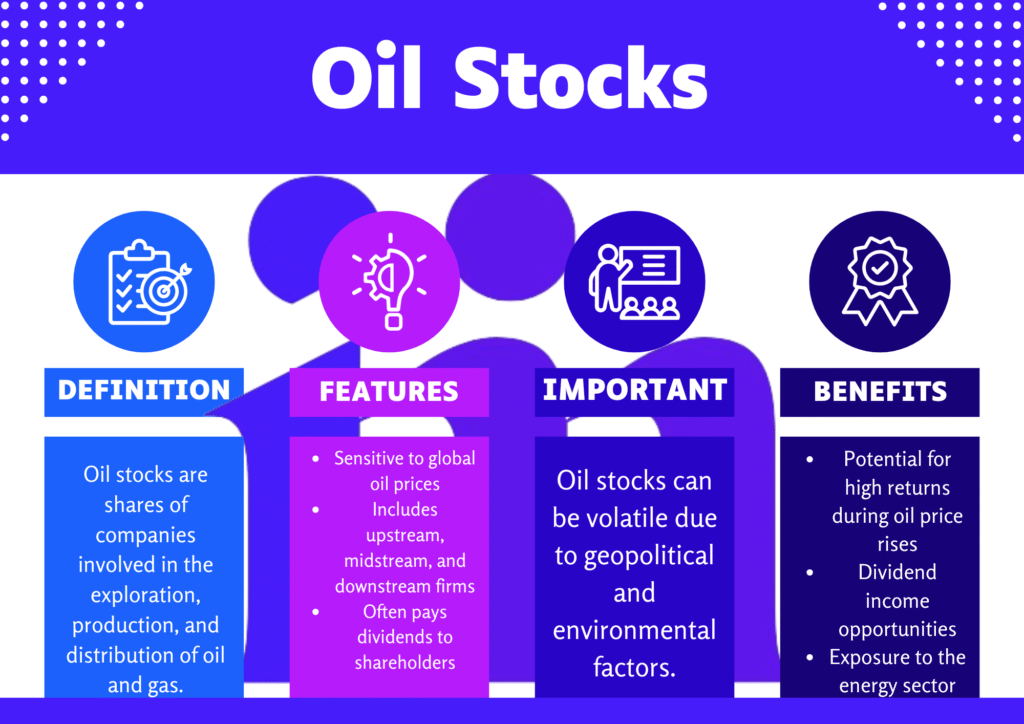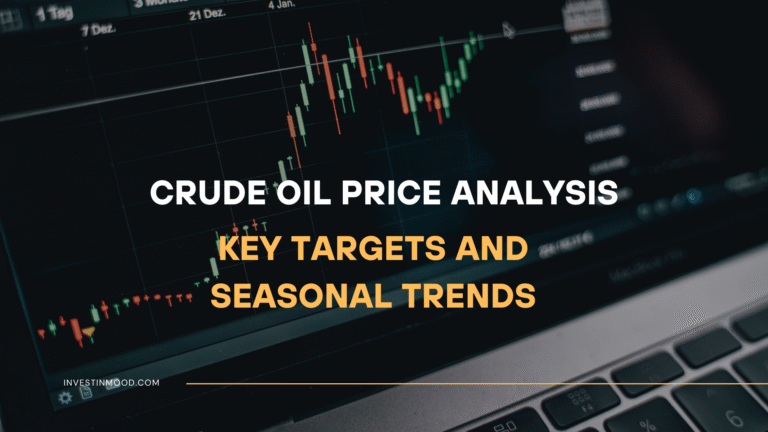
The energy sector has long been a cornerstone of the global economy, and within it, oil stocks represent some of the most impactful and potentially lucrative investment opportunities. From large-cap integrated majors to smaller exploration and production firms, oil equities offer investors access to the broader energy market. In this article, we’ll explore what oil stocks are, how to analyze them, top oil stocks to consider, and the potential benefits and risks from beginner basics to advanced strategies.
KEY TAKEAWAYS

What Are Oil Stocks
Oil stocks are shares of corporations employed in the exploration, extraction, refining, transportation, and sale of crude oil and petroleum products. These corporations range from international corporations to small operators and occupy several roles within the oil supply chain.
Having tracked oil markets for years, I’ve seen how easy it is to get caught up in short-term price rallies. What separates successful investors is their ability to think in cycles not headlines. Oil is as much a macro play as it is a company play, and integrating both views is key. The best gains often come from staying patient and contrarian when the sector feels out of favor.
Types of Oil Stocks
- Upstream
Companies focused on exploration and production (E&P) of crude oil (e.g., ConocoPhillips). - Midstream
Firms concentrating in the conveyance and storage of oil (e.g., Kinder Morgan). - Downstream
Businesses involved in refining crude oil and distributing petroleum products to consumers (e.g., Valero Energy). - Integrated
Major corporations operating across all three segments (e.g., ExxonMobil, Chevron, Shell).
Volatility in oil prices isn’t just market-driven it’s also politically reactive. Unexpected geopolitical conflicts, OPEC decisions, or natural disasters can cause sharp price movements overnight. Always consider global macroeconomic environments when estimating oil investments.
Why Invest in Oil Stocks
- Global Demand for Oil
Oil is a fundamental commodity, operating transportation, constructing, and residential energy. Despite growth in renewables, oil stays a global necessity. - Attractive Dividend Yields
Many established oil companies offer strong and consistent dividend payments, appealing to income-oriented investors. - Inflation Hedge
Oil prices often rise with inflation, making oil equities a strategic hedge against declining purchasing power. - Geopolitical Leverage
Global events wars, sanctions, or OPEC decisions can drive oil prices, impacting stock valuations accordingly.
Diversify within the oil sector. Don’t just invest in upstream producers consider balancing your portfolio with midstream infrastructure companies and downstream refiners. These segments often respond differently to oil price movements, helping stabilize returns.
How to Evaluate Oil Stocks
- Understand the Segment (Upstream, Midstream, Downstream)
Each segment reacts differently to oil price fluctuations. Integrated companies offer broad exposure, while pure-play firms provide more targeted performance. - Assess Financial Strength
Look for low debt-to-equity ratios, positive free cash flow, and robust liquidity. Financially sound firms weather downturns and capitalize during upcycles. - Analyze Dividend Performance
Consistent dividend payouts signal financial health and management confidence. Review yield, payout ratio, and dividend growth history. - Evaluate Reserve Replacement Ratio (RRR)
This observation displays how efficiently a company reloads its reserves. An RRR above 100% indicates bearable production and long-term sustainability. - Understand Sensitivity to Crude Prices
Determine how each stock correlates with WTI or Brent benchmarks. Some firms hedge prices, reducing short-term volatility. - Review ESG Ratings
ESG performance is increasingly affecting capital flows. Companies with high ESG scores may face fewer regulatory risks and attract more institutional investment. - Scrutinize Management and Strategy
Competent leadership and forward-looking capital allocation drive long-term performance. Focus on firms investing in innovation and transition strategies. - Consider Geographic Risk Exposure
Political risk varies by region. U.S.-based operations may offer more stability, while international exposure brings both diversification and complexity. - Examine Production Costs and Efficiency
Low-cost producers tend to be more resilient in price downturns. Evaluate cost-per-barrel relative to industry standards. - Leverage Analyst Insights
Equity research can offer guidance on valuation, SWOT analysis, and macroeconomic outlooks. Use these insights to supplement your own due diligence.
In 2020, during the COVID-19 pandemic, oil prices briefly turned negative a first in history due to oversupply and collapsing demand. Companies like ExxonMobil saw steep valuation drops, but rebounded strongly by 2022 as demand surged back. Investors who held through the turmoil or bought during the dip saw substantial returns.
Top 10 Oil Stocks to Watch
| Company | Segment | Highlights |
|---|---|---|
| ExxonMobil (XOM) | Integrated | Massive scale, strong dividend history, investing in carbon capture and renewables. |
| Chevron (CVX) | Integrated | Resilient through oil price cycles, solid balance sheet, reliable dividends. |
| ConocoPhillips (COP) | Upstream | Efficient, low-cost operations focused on E&P. |
| Schlumberger (SLB) | Oilfield Services | Leading provider of technology and services for global drilling and production. |
| EOG Resources (EOG) | Upstream (Shale) | Pioneer in U.S. shale, known for cost control and innovation. |
| Occidental Petroleum (OXY) | Upstream | Strong U.S. operations, supported by Berkshire Hathaway. |
| Kinder Morgan (KMI) | Midstream | Extensive pipeline network, stable cash flow, high dividend yield. |
| Phillips 66 (PSX) | Downstream | Concentrates in purifying and advertising; benefits from cleansing limitations. |
| Valero Energy (VLO) | Downstream | Major independent refiner, excels during high crude environments. |
| Shell Plc (SHEL) | Integrated | Global footprint, active in energy transition, attractive valuation. |
Benefits of Investing in Oil Stocks
- Reliable Income via Dividends
Many oil majors offer strong and consistent payouts, especially attractive in low-rate environments. Reinvesting bonuses can increase capital with time. - Sustained Energy Demand
As global economies expand, particularly in emerging markets, oil demand remains robust fueling steady revenue streams. - Cyclical Opportunity
Investors can capitalize on oil’s cyclical nature by buying during downturns and selling into rallies for enhanced returns. - Diversification Benefits
Oil stocks provide exposure to a sector that behaves differently from tech or healthcare, reducing portfolio correlation. - Commodity Exposure Without Futures
Oil stocks offer indirect access to crude prices, enabling participation in commodity trends without the complexity of futures trading.
Over 90% of global transportation still depend on petroleum items for consumption. Even with the rise of electric vehicles, the infrastructure and logistics industries remain heavily dependent on oil, indicating persistent demand in the coming decades.
Risks and Encounters of Investing in Oil Stocks
- Volatility
Oil prices are subject to rapid changes due to geopolitical tension, OPEC policies, and macroeconomic events. - Regulatory Risk
Stricter environmental laws can raise operational costs and limit production, affecting profitability. - Transition to Renewables
The global shift toward clean energy poses long-term challenges for fossil fuel companies unless they adapt. - Environmental Liability
Accidents, emissions, and ecological impact expose firms to lawsuits, fines, and reputational damage. - Capital Intensity
Exploration and infrastructure projects require massive investment and long lead times, increasing financial risk.
Don’t chase high-yield oil stocks blindly. Some companies offer unsustainably high dividends to attract investors, even while facing declining cash flow and poor fundamentals. Always cross-check yield with payout ratio, debt levels, and profitability.
Pros and Cons of Oil Stocks
| Pros | Cons |
|---|---|
| ✔ High dividend yields from stable energy firms. | ✘ Long-term risk from energy transition. |
| ✔ Strong upside during oil price recoveries. | ✘ Exposure to geopolitical volatility. |
| ✔ Useful for portfolio diversification. | ✘ Regulatory and environmental pressures. |
| ✔ Access to global energy infrastructure. | ✘ High short-term price fluctuations. |
Advanced Tips for Oil Stock Investors
- Track Crude Benchmarks (WTI, Brent)
Stock movements are closely tied to these prices. Monitoring them helps with entry and exit timing. - Follow OPEC Decisions
OPEC’s production adjustments frequently lead to immediate value swings. Stay updated on meeting outcomes and proportions. - Analyze Break-even Prices
Lower break-even costs indicate stronger resilience during price drops. Seek companies with strong operational efficiency. - Monitor Reserve Replacement Ratios (RRR)
A ratio above 100% signals that a company is securing future production, which supports long-term growth. - Balance ESG and Profitability
Companies actively managing ESG issues are more likely to secure investment, avoid penalties, and build long-term value.
Conclusion
Oil stocks offer investors a gateway into one of the world’s most vital and dynamic sectors. From stable dividends to cyclical profit opportunities, they remain relevant even amid the global energy transition. Whether you’re a novice or a seasoned investor, understanding the structure of oil companies, how to evaluate them, and the broader market dynamics will empower smarter investment decisions.
As with any asset class, diversification and thorough research are key. Oil stocks carry both significant upside and meaningful risks. For investors prepared to manage volatility and monitor industry cycles, the oil sector can deliver compelling long-term returns.






